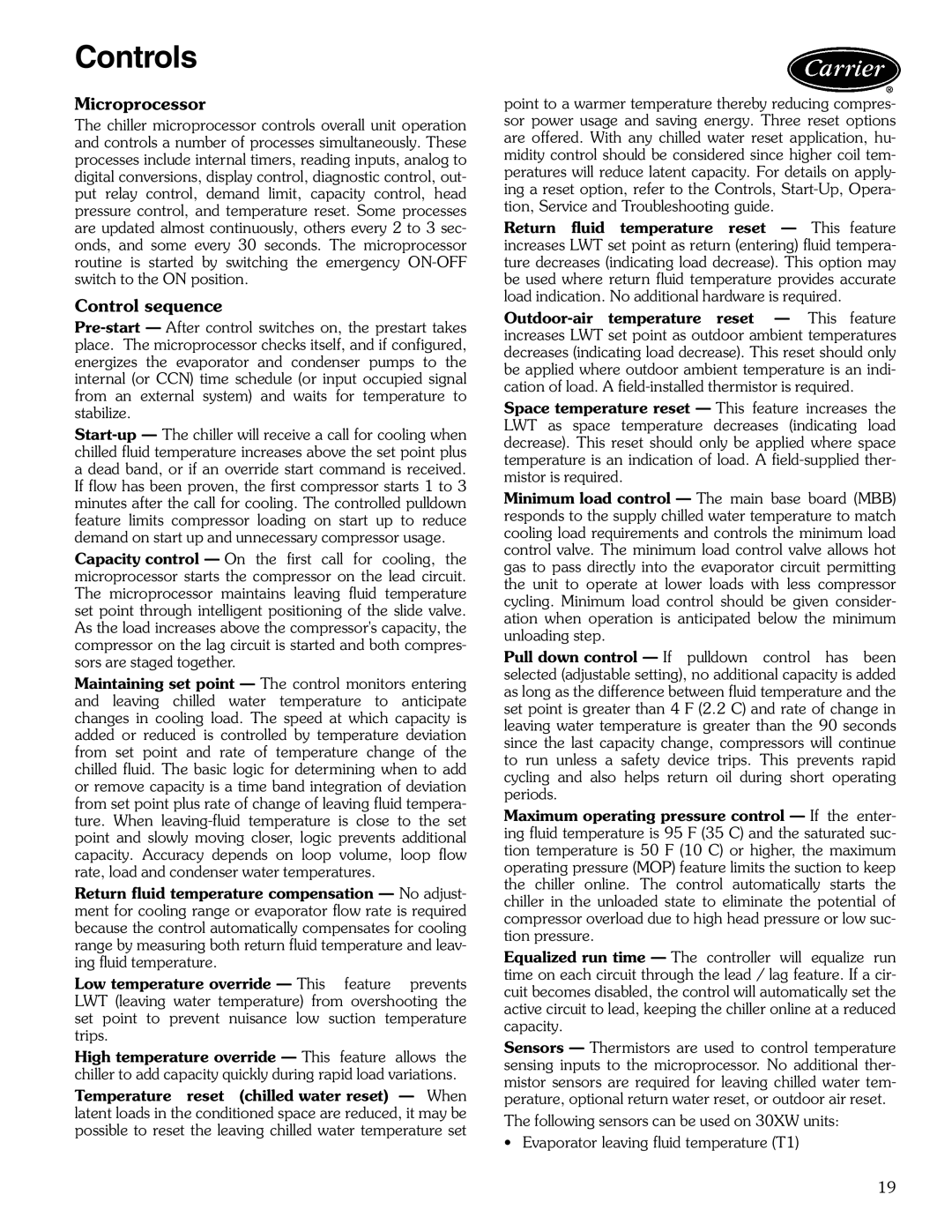Controls
Microprocessor
The chiller microprocessor controls overall unit operation and controls a number of processes simultaneously. These processes include internal timers, reading inputs, analog to digital conversions, display control, diagnostic control, out- put relay control, demand limit, capacity control, head pressure control, and temperature reset. Some processes are updated almost continuously, others every 2 to 3 sec- onds, and some every 30 seconds. The microprocessor routine is started by switching the emergency
Control sequence
Capacity control — On the first call for cooling, the microprocessor starts the compressor on the lead circuit. The microprocessor maintains leaving fluid temperature set point through intelligent positioning of the slide valve. As the load increases above the compressor's capacity, the compressor on the lag circuit is started and both compres- sors are staged together.
Maintaining set point — The control monitors entering and leaving chilled water temperature to anticipate changes in cooling load. The speed at which capacity is added or reduced is controlled by temperature deviation from set point and rate of temperature change of the chilled fluid. The basic logic for determining when to add or remove capacity is a time band integration of deviation from set point plus rate of change of leaving fluid tempera- ture. When
Return fluid temperature compensation — No adjust- ment for cooling range or evaporator flow rate is required because the control automatically compensates for cooling range by measuring both return fluid temperature and leav- ing fluid temperature.
Low temperature override — This feature prevents LWT (leaving water temperature) from overshooting the set point to prevent nuisance low suction temperature trips.
High temperature override — This feature allows the chiller to add capacity quickly during rapid load variations.
Temperature reset (chilled water reset) — When latent loads in the conditioned space are reduced, it may be possible to reset the leaving chilled water temperature set
point to a warmer temperature thereby reducing compres- sor power usage and saving energy. Three reset options are offered. With any chilled water reset application, hu- midity control should be considered since higher coil tem- peratures will reduce latent capacity. For details on apply- ing a reset option, refer to the Controls,
Return fluid temperature reset — This feature increases LWT set point as return (entering) fluid tempera- ture decreases (indicating load decrease). This option may be used where return fluid temperature provides accurate load indication. No additional hardware is required.
Space temperature reset — This feature increases the LWT as space temperature decreases (indicating load decrease). This reset should only be applied where space temperature is an indication of load. A
Minimum load control — The main base board (MBB) responds to the supply chilled water temperature to match cooling load requirements and controls the minimum load control valve. The minimum load control valve allows hot gas to pass directly into the evaporator circuit permitting the unit to operate at lower loads with less compressor cycling. Minimum load control should be given consider- ation when operation is anticipated below the minimum unloading step.
Pull down control — If pulldown control has been selected (adjustable setting), no additional capacity is added as long as the difference between fluid temperature and the set point is greater than 4 F (2.2 C) and rate of change in leaving water temperature is greater than the 90 seconds since the last capacity change, compressors will continue to run unless a safety device trips. This prevents rapid cycling and also helps return oil during short operating periods.
Maximum operating pressure control — If the enter- ing fluid temperature is 95 F (35 C) and the saturated suc- tion temperature is 50 F (10 C) or higher, the maximum operating pressure (MOP) feature limits the suction to keep the chiller online. The control automatically starts the chiller in the unloaded state to eliminate the potential of compressor overload due to high head pressure or low suc- tion pressure.
Equalized run time — The controller will equalize run time on each circuit through the lead / lag feature. If a cir- cuit becomes disabled, the control will automatically set the active circuit to lead, keeping the chiller online at a reduced capacity.
Sensors — Thermistors are used to control temperature sensing inputs to the microprocessor. No additional ther- mistor sensors are required for leaving chilled water tem- perature, optional return water reset, or outdoor air reset.
The following sensors can be used on 30XW units:
• Evaporator leaving fluid temperature (T1)
19
